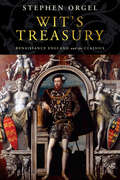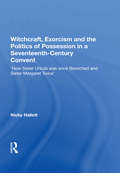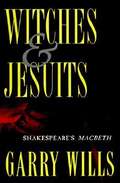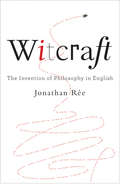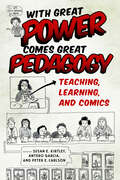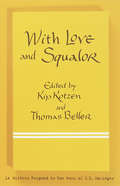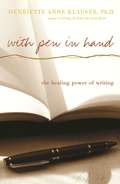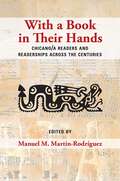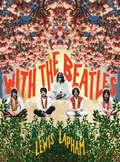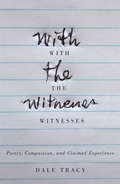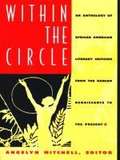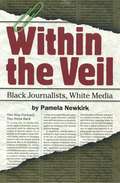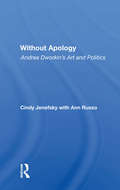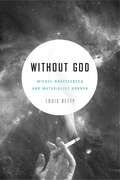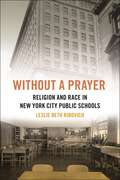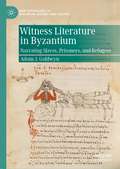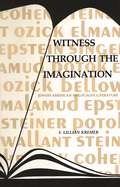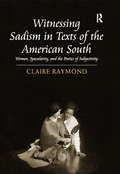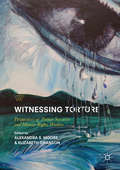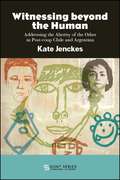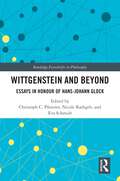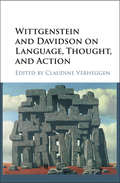- Table View
- List View
Wit's Treasury: Renaissance England and the Classics
by Stephen OrgelAs England entered the Renaissance and as humanism, with its focus on classical literature and philosophy, informed the educational system, English intellectuals engaged in a concerted effort to remake the culture, language, manners—indeed, the whole national style—through adapting the classics. But how could English literature, art, and culture, become "classical," not only in imitating the ancients, but in the sense subsequently applied to music: "classical" as opposed to popular, as formal, serious, and therefore as good?For several decades in the sixteenth and early seventeenth centuries, Stephen Orgel writes, the return to the classics held out the promise of refinement and civility. Poetry was to be modeled on Greek and Roman examples rather than on the great English medieval works, which though admirable, lacked "correctness." More than poetry was at stake, however, and the transition would not be easy. Classical rules seemed the wave of the future, rescuing England from what was seen as the crudeness and the sheer popularity of its native traditions, but advocacy was tempered with a good deal of ambivalence: classical manners and morals were often at variance with Christian principles, and the classicism of the age would need to be deeply revisionist. "Christian humanism" was never untroubled, Orgel writes, always an unstable or even paradoxical amalgam.In Wit's Treasury, one of our foremost interpreters of Renaissance literature and culture charts how this ambivalence yielded the rich creative tension out of which emerged an unprecedented flowering of drama, lyric, and the arts. Orgel has here written a book that will appeal to anyone interested in English Renaissance art and literature, and particularly in the cultural ferment that produced Shakespeare, Marlowe, Spenser, Jonson, and Milton.
Witchcraft, Exorcism and the Politics of Possession in a Seventeenth-Century Convent: 'How Sister Ursula was once Bewiched and Sister Margaret Twice' (The\early Modern Englishwoman 1500-1750 Ser.)
by Nicky HallettPresenting a remarkable set of previously unpublished papers, this book concerns the bewitchment, possession and exorcism of two seventeenth-century nuns living in exile in an English convent in the Spanish Netherlands. The two women left behind an extensive set of personal writing that reveals unprecedented detail about their devotional lives and spiritual states before, during and after exorcism. Unlike other similar cases, here the women write for themselves; for the first time in 350 years this book allows their voices - and their silences - to resound in all their vibrancy. An extensive introduction discusses the politics of piety and possession at a time when exorcism had become increasingly contentious, amidst conflicting claims for rival church reform. The book includes both autobiographical and biographical material, written by the nuns and about them, and casting new light on processes of female self-writing at just the time when the 'modern subject' is often said to have emerged.
Witches and Jesuits: Shakespeare's Macbeth
by Garry WillsIn Witches and Jesuits, Wills focuses on a single document to open up a window on an entire society. He begins with a simple question: If Macbeth is such a great tragedy, why do performances of it so often fail? After all, the stage history of Macbeth is so riddled with disasters that it has created a legendary curse on the drama. Superstitious actors try to evade the curse by referring to Macbeth only as "the Scottish play," but production after production continues to soar in its opening scenes, only to sputter towards anticlimax in the later acts. By critical consensus there seems to have been only one entirely successful modern performance of the play, Laurence Olivier's in 1955, and even Olivier twisted his ankle on opening night. But Olivier's ankle notwithstanding, Wills maintains that the fault lies not in Shakespeare's play, but in our selves. Drawing on his intimate knowledge of the vivid intrigue and drama of Jacobean England, Wills restores Macbeth's suspenseful tension by returning it to the context of its own time, recreating the burning theological and political crises of Shakespeare's era. He reveals how deeply Macbeth's original 1606 audiences would have been affected by the notorious Gunpowder Plot of 1605, when a small cell of Jesuits came within a hairbreadth of successfully blowing up not only the King, but the Prince his heir, and all members of the court and Parliament. Wills likens their shock to that endured by Americans following Pearl Harbor or the Kennedy assassination. Furthermore, Wills documents, the Jesuits were widely believed to be acting in the service of the Devil, and so pervasive was the fear of witches that just two years before Macbeth's first performance, King James I added to the witchcraft laws a decree of death for those who procured "the skin, bone, or any other part of any dead person--to be employed or used in any manner of witchcraft, sorcery, charm, or enchantment." We see that the treason and necromancy in Macbeth were more than the imaginings of a gifted playwright--they were dramatizations of very real and potent threats to the realm. In this new light, Macbeth is transformed. Wills presents a drama that is more than a well-scripted story of a murderer getting his just penalty, it is the struggle for the soul of a nation. The death of a King becomes a truly apocalyptic event, and Malcolm, the slain King's son, attains the status of a man defying cosmic evil. The guilt of Lady Macbeth takes on the Faustian aspect of one who has singed her hands in hell. The witches on the heath, shrugged off as mere symbols of Macbeth's inner guilt and ambition by twentieth century interpreters, emerge as independent agents of the occult with their own (or their Master's) terrifying agendas. Restoring the theological politics and supernatural elements that modern directors have shied away from, Wills points the way towards a Macbeth that will finally escape the theatrical curse on "the Scottish play." Rich in insight and a joy to read, Witches and Jesuits is a tour de force of scholarship and imagination by one of our foremost writers, essential reading for anyone who loves the language.
Witcraft: The Invention of Philosophy in English
by Jonathan RéeAn ambitious new history of philosophy in English that broadens the canon to include many lesser-known figures Ludwig Wittgenstein once wrote that “philosophy should be written like poetry.” But philosophy has often been presented more prosaically as a long trudge through canonical authors and great works. But what, Jonathan Rée asks, if we instead saw the history of philosophy as a haphazard series of unmapped forest paths, a mass of individual stories showing endurance, inventiveness, bewilderment, anxiety, impatience, and good humor? Here, Jonathan Rée brilliantly retells this history, covering such figures as Descartes, Locke, Kant, Hegel, Marx, Nietzsche, Mill, James, Frege, Wittgenstein, and Sartre. But he also includes authors not usually associated with philosophy, such as William Hazlitt, George Eliot, Darwin, and W. H. Auden. Above all, he uncovers dozens of unremembered figures—puritans, revolutionaries, pantheists, feminists, nihilists, socialists, and scientists—who were passionate and active readers of philosophy, and often authors themselves. Breaking away from high-altitude narratives, he shows how philosophy finds its way into ordinary lives, enriching and transforming them in unexpected ways.
With Great Power Comes Great Pedagogy: Teaching, Learning, and Comics
by Susan E. Kirtley, Antero Garcia and Peter E. CarlsonContributions by Bart Beaty, Jenny Blenk, Ben Bolling, Peter E. Carlson, Johnathan Flowers, Antero Garcia, Dale Jacobs, Ebony Flowers Kalir, James Kelley, Susan E. Kirtley, Frederik Byrn Køhlert, John A. Lent, Leah Misemer, Johnny Parker II, Nick Sousanis, Aimee Valentine, and Benjamin J. Villarreal More and more educators are using comics in the classroom. As such, this edited volume sets out the stakes, definitions, and exemplars of recent comics pedagogy, from K-12 contexts to higher education instruction to ongoing communities of scholars working outside of the academy. Building upon interdisciplinary approaches to teaching comics and teaching with comics, this book brings together diverse voices to share key theories and research on comics pedagogy. By gathering scholars, creators, and educators across various fields and in K-12 as well as university settings, editors Susan E. Kirtley, Antero Garcia, and Peter E. Carlson significantly expand scholarship. This valuable resource offers both critical pieces and engaging interviews with key comics professionals who reflect on their own teaching experience and on considerations of the benefits of creating comics in education. Included are interviews with acclaimed comics writers Lynda Barry, Brian Michael Bendis, Kelly Sue DeConnick, and David Walker, as well as essays spanning from studying the use of superhero comics in the classroom to the ways comics can enrich and empower young readers. The inclusion of creators, scholars, and teachers leads to perspectives that make this volume unlike any other currently available. These voices echo the diverse needs of the many stakeholders invested in using comics in education today.
With Her Machete in Her Hand: Reading Chicana Lesbians
by Catrióna Rueda EsquibelWith the 1981 publication of the groundbreaking anthology This Bridge Called My Back: Writings by Radical Women of Color, Cherríe Moraga and Gloria Anzaldúa ushered in an era of Chicana lesbian writing. <P><P>But while these two writers have achieved iconic status, observers of the Chicana/o experience have been slow to perceive the existence of a whole community--lesbian and straight, male as well as female--who write about the Chicana lesbian experience. To create a first full map of that community, this book explores a wide range of plays, novels, and short stories by Chicana/o authors that depict lesbian characters or lesbian desire. <P> Catrióna Rueda Esquibel starts from the premise that Chicana/o communities, theories, and feminisms cannot be fully understood without taking account of the perspectives and experiences of Chicana lesbians. To open up these perspectives, she engages in close readings of works centered around the following themes: La Llorona, the Aztec Princess, Sor Juana Inés de la Cruz, girlhood friendships, rural communities and history, and Chicana activism. Her investigation broadens the community of Chicana lesbian writers well beyond Moraga and Anzaldúa, while it also demonstrates that the histories of Chicana lesbians have had to be written in works of fiction because these women have been marginalized and excluded in canonical writings on Chicano life and experience.
With Literacy and Justice for All: Rethinking the Social in Language and Education (Language, Culture, and Teaching Series)
by Carole EdelskyThe third edition of With Literacy and Justice for All: Rethinking the Social in Language and Education continues to document Carole Edelsky's long involvement with socially critical, holistic approaches to the everyday problems and possibilities facing teachers of language and literacy. This book helps education professionals understand the educational/societal situations they are dealing with, and literacy instruction and second language learning in particular contexts. Edelsky does not offer simplistic pedagogical formulas, but rather, progressively works through differences and tensions in the discourses and practices of sociolinguistics, bilingual education, whole language, and critical pedagogy--fields whose practitioners and advocates too often work in isolation from each other and, at times, at cross purposes. In this edition, what Edelsky means by rethinking is improving and extending her own views, while at the same time demonstrating that such rethinking always occurs in the light of history. The volume includes a completely new Introduction and two entirely new chapters: one on reconceptualizing literacy learning as second language learning, and another on taking a historical view of responses to standardized testing. Throughout, in updating the volume, Edelsky uses a variety of structural styles to note contrasts in her views across time and to make the distinction clear between the original material and the current additions. This edition is a rare example of a scholarly owning-up to changes in thinking, and a much needed demonstration of the historically grounded nature of knowledge. As a whole, the third edition emphasizes recursiveness and questioning within a deliberately political framework.
With Love and Squalor: 13 Writers Respond to the Work of J. D. Salinger
by Kip Kotzen Thomas BellerReading The Catcher in the Rye has become a rite of passage for young Americans, landing the book on bestseller lists (and banned book lists) each year, even though it was published a half century ago. What is it about J. D. Salinger and his body of work that has left such a lasting mark on American fiction? And who better to answer that question than the current generation of writers? Here are fourteen of the most vital voices in the contemporary American fiction scene pulling no punches in response to a writer who continues to beguile, charm, fascinate, and frustrate generations of readers. Contributors Walter Kirn, Ren Steinke, Charles D'Ambrosio, Emma Forrest, Aleksander Hemon, Lucinda Rosenfeld, Amy Sohn, John McNally, Karen E. Bender, Thomas Beller, Benjamin Anastas, Aimee Bender, Joel Stein, and Jane Mendelsohn turn themselves inside out as they discuss their personal reactions to reading Salinger classics--not only The Catcher in the Rye but also Franny and Zooey, Raise High the Roofbeams, Carpenters, and the short stories--and explore, with begrudging gratitude, how Salinger helped to form the deepest reaches of their literary imaginations.
With Pen in Hand: The Healing Power of Writing
by Henriette Anne KlauserIn moments of grief or loss, we often turn to the written word to say what cannot be said aloud. Indeed, directing sadness, rage, or confusion at the page can be tremendously cathartic and liberating. As we express our deepest feelings without reserve in poetry or prose, we feel the power of our words begin to draw out some of the pain in our hearts and replace it with hope. But fears about writing honestly and self-criticism can stand in the way of making use of this powerful therapeutic tool. With Pen in Hand is an inspirational and practical guide to breaking through these roadblocks and to helping one "write to heal. " Outlining writing techniques that are best for working through pain and for privately collecting raw emotions--"Writing a Letter of Goodbye," "Interviewing Your Body," "Rapid-Writing," and more--Henriette Klauser shares stories and tips that will help readers gain comfort from what they commit to paper. For the accomplished writer and non-writer alike, With Pen in Hand will help one make use of the kind of expression that in the aftermath of a crisis or loss, can make one whole again.
With a Book in Their Hands: Chicano/a Readers and Readerships across the Centuries
by Manuel M. Martín-RodríguezFirst Place Winner of the 2015 International Latino Book Award for Best Latino Focused Nonfiction Book Literary history is a history of reading. What happens during the act of reading is the subject of the branch of literary scholarship known as reader-response theory. Does the text guide the reader? Does the reader operate independently of the text? Questions like these shape the approach of the essays in this book, edited by a scholar known for his groundbreaking work in using reader-response theory as a window into Chicana and Chicano literature. Manuel M. Martín-Rodríguez has overseen several research projects aimed at documenting Chicana and Chicano reading practices and experiences. Here he gathers diverse and passionate accounts of reading drawn from that research. For many, books served as refuges from the sorrows of a childhood marked by violence or parental abandonment. Several of the contributors here salute the roles of teachers in introducing poetry and stories into their lives.
With the Beatles
by Lewis LaphamHalfway between the summer of love and the Tet offensive, the Beatles went to India to study with the Maharishi--and Lewis Lapham, esteemed Harper's editor and award-winning writer, was there. WITH THE BEATLES is a remarkable book of cultural commentary on that seminal '60s moment.The ashram in Rishikesh, India was the ultimate '60s scene: the Beatles, Donovan, Mia Farrow, a stray Beach Boy and other '60s icons gathered along the shores of the Ganges--amidst paisley and incense and flowers and guitars--to meditate at the feet of the Maharishi Mahesh Yogi. The February 1968 gathering received such frenzied, world-wide attention that it is still considered a significant, early encounter between Western pop culture and the mystical East. And Lewis Lapham was the only journalist allowed inside.And what went on inside the compound has long been the subject of wild speculation and rampant rumor. The Beatles said they wrote some of their greatest songs there . . . and yet they also came away bitterly disillusioned. In WITH THE BEATLES, Lewis Lapham finally tells the whole story.
With the Witnesses: Poetry, Compassion, and Claimed Experience
by Dale TracyWhile trauma theory has been adopted by contemporary literary and cultural studies as an ethical way to study depictions of suffering, there is a risk that its present use could cause more harm than good. By emphasizing inaccessible histories, unspeakable suffering, and unconscious witnessing, trauma theory may lead readers to claim others’ suffering through empathic identification. In With the Witnesses, Dale Tracy argues that poetry offers an alternative approach to engage with not only suffering in art but suffering in general. Examining the strategies of witness poetry, Tracy interrogates and reformulates the dominant models of trauma studies in which readers take over the witnessing position by identifying with the speaker as a witness, thus becoming witnesses themselves. If the purpose of reading such poetry is to contribute new witnesses to a chain, what is the distinct role of a reader? How does this role differ from the speaker of a poem’s role? Tracy proposes that metonymy – a logic of nearness rather than likeness – is compassion’s formal manifestation. Analyzing poetry that emphasizes the contiguity of metonymy over the substitution of metaphor, she attends to the positions into which witnessing speakers invite readers. Poems that respond to diverse national and transnational contexts of atrocity, conflict, and marginalization guide With the Witnesses toward a compassionate response to suffering that involves feeling with – not as – another. Following each poem as a unique theory of compassion, With the Witnesses demonstrates that poems hold suffering signed as art, not claimable traces of suffering.
Within the Circle: An Anthology of African American Literary Criticism from the Harlem Renaissance to the Present
by Angelyn MitchellWithin the Circle is the first anthology to present the entire spectrum of twentieth-century African American literary and cultural criticism. It begins with the Harlem Renaissance, continues through civil rights, the Black Arts Movement, and on into contemporary debates of poststructuralist and black feminist theory. Drawing on a quote from Frederick Douglass for the title of this book, Angelyn Mitchell explains in her introduction the importance for those "within the circle" of African American literature to examine their own works and to engage this critical canon.The essays in this collection--many of which are not widely available today--either initiated or gave critical definition to specific periods or movements of African American literature. They address issues such as integration, separatism, political action, black nationalism, Afrocentricity, black feminism, as well as the role of art, the artist, the critic, and the audience. With selections from Langston Hughes, Sterling Brown, W. E. B. DuBois, Zora Neale Hurston, Richard Wright, James Baldwin, Toni Morrison, Barbara Smith, Alice Walker, Henry Louis Gates, Jr., and many others, this definitive collection provides a dynamic model of the cultural, ideological, historical, and aesthetic considerations in African American literature and literary criticism.A major contribution to the study of African American literature, this volume will serve as a foundation for future work by students and scholars. Its importance will be recognized by all those interested in modern literary theory as well as general readers concerned with the African American experience.Selections by (partial list): Houston A. Baker, Jr., James Baldwin, Sterling Brown, Barbara Christian, W. E. B. DuBois, Ralph Ellison, LeRoi Jones, Sarah Webster Fabio, Henry Louis Gates, Jr., W. Lawrence Hogue, Langston Hughes, Zora Neale Hurston, Alain Locke, Deborah E. McDowell, Toni Morrison, J. Saunders Redding, George Schuyler, Barbara Smith, Valerie Smith, Hortense J. Spillers, Robert B. Stepto, Alice Walker, Margaret Walker, Mary Helen Washington, Richard Wright
Within the Veil: Black Journalists, White Media
by Pamela NewkirkWinner of the National Press Club Prize for Media CriticismUnmasks race-related conflicts in the newsrooms and the push for more equitable coverage of racial minorities Thirty years ago, the Kerner Commission Report made national headlines by exposing the consistently biased coverage afforded African Americans in the mainstream media. While the report acted as a much ballyhooed wake-up call, the problems it identified have stubbornly persisted, despite the infusion of black and other racial minority journalists into the newsroom. In Within the Veil, Pamela Newkirk unmasks the ways in which race continues to influence reportage, both overtly and covertly. Newkirk charts a series of race-related conflicts at news organizations across the country, illustrating how African American journalists have influenced and been denied influence to the content, presentation, and very nature of news. Through anecdotes culled from interviews with over 100 broadcast and print journalists, Newkirk exposes the trials and triumphs of African American journalists as they struggle in pursuit of more equitable coverage of racial minorities. She illuminates the agonizing dilemmas they face when writing stories critical of blacks, stories which force them to choose between journalistic integrity, their own advancement, and the almost certain enmity of the black community. Within the Veil is a gripping front-line report on the continuing battle to integrate America's newsrooms and news coverage.Companion website: http://www.nyupress.nyu.edu/authors/veil.html
Without Apology: Andrea Dworkin's Art And Politics
by Cindy JenefskyThis is the first-ever book-length analysis of Dworkins feminist politics and the first critical analysis to examine her controversial political ideas in light of the literary dimensions of her prose. Cindy Jenefsky, with Ann Russo, looks at Dworkin’s major nonfiction works including Woman Hating, Pornography: Men Possessing Women, and Intercourse
Without God: Michel Houellebecq and Materialist Horror
by Louis BettyMichel Houellebecq is France’s most famous and controversial living novelist. Since his first novel in 1994, Houellebecq’s work has been called pornographic, racist, sexist, Islamophobic, and vulgar. His caricature appeared on the cover of the French satirical weekly Charlie Hebdo on January 7, 2015, the day that Islamist militants killed twelve people in an attack on their offices and also the day that his most recent novel, Soumission—the story of France in 2022 under a Muslim president—appeared in bookstores. Without God uses religion as a lens to examine how Houellebecq gives voice to the underside of the progressive ethos that has animated French and Western social, political, and religious thought since the 1960s.Focusing on Houellebecq’s complicated relationship with religion, Louis Betty shows that the novelist, who is at best agnostic, “is a deeply and unavoidably religious writer.” In exploring the religious, theological, and philosophical aspects of Houellebecq’s work, Betty situates the author within the broader context of a French and Anglo-American history of ideas—ideas such as utopian socialism, the sociology of secularization, and quantum physics. Materialism, Betty contends, is the true destroyer of human intimacy and spirituality in Houellebecq’s work; the prevailing worldview it conveys is one of nihilism and hedonism in a postmodern, post-Christian Europe. In Betty’s analysis, “materialist horror” emerges as a philosophical and aesthetic concept that describes and amplifies contemporary moral and social decadence in Houellebecq’s fiction.
Without a Prayer: Religion and Race in New York City Public Schools (North American Religions #24)
by Leslie Beth RibovichReframes religion’s role in twentieth-century American public educationThe processes of secularization and desegregation were among the two most radical transformations of the American public school system in all its history. Many regard the 1962 and 1963 US Supreme Court rulings against school prayer and Bible-reading as the end of religion in public schools. Likewise, the 1954 Brown v. Board of Education case is seen as the dawn of school racial equality. Yet, these two major twentieth-century American educational movements are often perceived as having no bearing on one another.Without a Prayer redefines secularization and desegregation as intrinsically linked. Using New York City as a window into a national story, the volume argues that these rulings failed to successfully remove religion from public schools, because it was worked into the foundation of the public education structure, especially how public schools treated race and moral formation. Moreover, even public schools that were not legally segregated nonetheless remained racially segregated in part because public schools rooted moral lessons in an invented tradition—Judeo-Christianity—and in whiteness.The book illuminates how both secularization and desegregation took the form of inculcating students into white Christian norms as part of their project of shaping them into citizens. Schools and religious and civic constituents worked together to promote programs such as juvenile delinquency prevention, moral and spiritual values curricula, and racial integration advocacy. At the same time, religiously and racially diverse community members drew on, resisted, and reimagined public school morality.Drawing on research from a number of archival repositories, newspaper and legal databases, and visual and material culture, Without a Prayer shows how religion and racial discrimination were woven into the very fabric of public schools, continuing to inform public education’s everyday practices even after the Supreme Court rulings.
Witness Literature in Byzantium: Narrating Slaves, Prisoners, and Refugees (New Approaches to Byzantine History and Culture)
by Adam J. GoldwynThis book analyzes Byzantine examples of witness literature, a genre that focuses on eyewitness accounts written by slaves, prisoners, refugees, and other victims of historical atrocity. It focuses on such episodes in three nonfictional texts – John Kaminiates’ Capture of Thessaloniki (904), Eustathios of Thessaloniki’s Capture of Thessaloniki (1186), and Niketas Choniates’ History (ca. 1204–17) – and the three extant twelfth-century Komnenian novels to consider how the authors’ positions as both eyewitness and victim require an interpretive method that distinguishes witness literature from other kinds of writing about the past. Drawing on theoretical developments in the fields of Holocaust and Genocide Studies (such as Giorgio Agamben’s homo sacer and Michel Foucault’s biopolitics) and comparisons with modern examples (Elie Wiesel’s Night and Primo Levi’s If This is a Man), Witness Literature emphasizes the affective, subjective, and experiential in medieval Greek historical writing.
Witness Through the Imagination: Jewish American Holocaust Literature
by S. Lillian Kremer Dr Lilian KremerCriticism of Holocaust literature is an emerging field of inquiry, and as might be expected, the most innovative work has been concentrated on the vanguard of European and Israeli Holocaust literature. Now that American fiction has amassed an impressive and provocative Holocaust canon, the time is propitious for its evaluation. Witness through the Imagination presents a critical reading of themes and stylistic strategies of major American Holocaust fiction to determine its capacity to render the prelude, progress, and aftermath of the Holocaust. <P><P> The unifying critical approach is the textual explication of themes and literary method, occasional comparative references to international Holocaust literature, and a discussion of extra-literary Holocaust sources that have influenced the creative writers' treatment of the Holocaust universe.
Witnessing Girlhood: Toward an Intersectional Tradition of Life Writing
by Elizabeth Marshall Leigh GilmoreWhen more than 150 women testified in 2018 to the sexual abuse inflicted on them by Dr. Larry Nassar when they were young, competitive gymnasts, they exposed and transformed the conditions that shielded their violation, including the testimonial disadvantages that cluster at the site of gender, youth, and race. In Witnessing Girlhood, Leigh Gilmore and Elizabeth Marshall argue that they also joined a long tradition of autobiographical writing led by women of color in which adults use the figure and narrative of child witness to expose harm and seek justice. Witnessing Girlhood charts a history of how women use life narrative to transform conditions of suffering, silencing, and injustice into accounts that enjoin ethical response. Drawing on a deep and diverse archive of self-representational forms—slave narratives, testimonio, memoir, comics, and picture books—Gilmore and Marshall attend to how authors return to a narrative of traumatized and silenced girlhood and the figure of the child witness in order to offer public testimony. Emerging within these accounts are key scenes and figures that link a range of texts and forms from the mid–nineteenth century to the contemporary period. Gilmore and Marshall offer a genealogy of the reverberations across timelines, self-representational acts, and jurisdictions of the child witness in life writing. Reconstructing these historical and theoretical trajectories restores an intersectional testimonial history of writing by women of color about sexual and racist violence to the center of life writing and, in so doing, furthers our capacity to engage ethically with representations of vulnerability, childhood, and collective witness.
Witnessing Sadism in Texts of the American South: Women, Specularity, and the Poetics of Subjectivity
by Claire RaymondLooking at works by Carrie Mae Weems, Toni Morrison, Emily Dickinson, Flannery O'Connor, Dorothy Allison, Carson McCullers, and Zora Neale Hurston, Claire Raymond uncovers a pattern of femininity constructed around representations of sadistic violence in American women's literature and photography from the late nineteenth and twentieth centuries. Dickinson's poetry is read through its relationship to the Southern Agrarian critics who championed her work. While the representations of violence found in Carrie Mae Weems's installation From Here I Saw What Happened and I Cried, Morrison's Beloved, Dickinson’s poetry, O'Connor's 'A View of the Woods' and 'A Good Man Is Hard to Find,' Allison's Bastard Out of Carolina, McCullers' Ballad of the Sad Café, and Hurston's Mules and Men are diverse in terms of artistic presentation, all allude to or are set in the antebellum and Jim Crow South. In addition, all involve feminine characters whose subjectivity is shaped by the practice of seeing acts of violence inflicted where there can be no effective resistance. While not proposing an equivalence between representing violence in visual images and written text, Raymond does suggest that visual images of violence can be interpreted in context with written evocations of violent imagery. Invoking sadism in its ethical sense of violence enacted on a victim for whom self-defense and recourse of any kind are impossible, Raymond's study is ultimately an exploration of the idea that a femininity constructed by the positioning of feminine characters as witnesses to sadistic acts is a phenomenon distinctly of the American South that is linked to the culture's history of racism.
Witnessing Torture: Perspectives of Torture Survivors and Human Rights Workers (Palgrave Studies in Life Writing)
by Elizabeth Swanson Alexandra S. MooreThis book demonstrates a new, interdisciplinary approach to life writing about torture that situates torture firmly within its socio-political context, as opposed to extending the long line of representations written in the idiom of the proverbial dark chamber. By dismantling the rhetorical divide that typically separates survivors’ suffering from human rights workers’ expertise, contributors engage with the personal, professional, and institutional dimensions of torture and redress. Essays in this volume consider torture from diverse locations – the Philippines, Argentina, Sudan, and Guantánamo, among others. From across the globe, contributors witness both individual pain and institutional complicity; the challenges of building communities of healing across linguistic and national divides; and the role of the law, art, writing, and teaching in representing and responding to torture.
Witnessing beyond the Human: Addressing the Alterity of the Other in Post-coup Chile and Argentina (SUNY series, Literature . . . in Theory)
by Kate JenckesThis book rethinks the nature of testimony beyond the ground of the human in works produced in Chile and Argentina from the 1970s to the present. Focusing on literature by Juan Gelman, Sergio Chejfec, and Roberto Bolaño, as well as art by Eugenio Dittborn, Kate Jenckes argues that these works represent life, death, and the relation between self and other "beyond the human," that is beyond the sense that we can know and represent ourselves and others, with powerful implications for our understanding of history, community, and politics. Jenckes engages with the work of Jacques Derrida together with the intellectually rigorous field of Chilean aesthetic theory to explore issues related to the nature of testimony.
Wittgenstein and Beyond: Essays in Honour of Hans-Johann Glock (Routledge Festschrifts in Philosophy)
by Eva Schmidt Christoph C. Pfisterer Nicole RathgebThis volume celebrates the work of Hans-Johann Glock, a philosopher renowned for both his exegesis of Wittgenstein and his many contributions to debates in contemporary philosophy. It brings together 16 new essays by up-and-coming and distinguished philosophers engaging with Glock’s work, and it concludes with a "Reflections and Replies" chapter in which Glock responds to his interlocutors. Glock’s distinctive philosophical voice features a rare combination of a Wittgenstein-inspired approach with a willingness to break away from Wittgenstein to tackle problems in an open-minded way. The broad selection of essays included in this volume reflects Glock’s wide-ranging philosophical interests and demonstrates the potential of applying Wittgensteinian insights to advance current systematic debates in philosophy. The chapters discuss Wittgenstein’s philosophy, metaphilosophy, truth and language, animal minds and agency, and reasons and normativity. Wittgenstein and Beyond will appeal to scholars and advanced students working on Wittgenstein, metaphilosophy, philosophy of mind, and philosophy of language.
Wittgenstein and Davidson on Language, Thought, and Action
by Verheggen ClaudineWittgenstein and Davidson are two of the most influential and controversial figures of twentieth-century philosophy. However, whereas Wittgenstein is often regarded as a deflationary philosopher, Davidson is considered to be a theory builder and systematic philosopher par excellence. Consequently, little work has been devoted to comparing their philosophies with each other. In this volume of new essays, leading scholars show that in fact there is much that the two share. By focusing on the similarities between Wittgenstein and Davidson, their essays present compelling defences of their views and develop more coherent and convincing approaches than either philosopher was able to propose on his own. They show how philosophically fruitful and constructive reflection on Wittgenstein and Davidson continues to be, and how relevant the writings of both philosophers are to current debates in philosophy of mind, language, and action.
